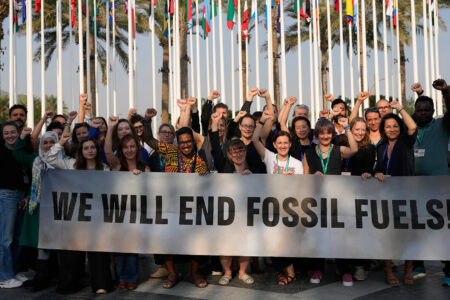
Donald Trump’s announcement that the United States will withdraw from the Paris Agreement has clearly outlined the challenge of leadership on climate action on this side of the Atlantic. Now is the time for Canada to step up and offer a North American climate vision, joining the rest of the world in mobilizing around the Paris Agreement and accelerating efforts to transition to a low-carbon economy.
Trump’s decision comes on the heels of a May 2017 report co-authored by more than 70 Canadian university researchers that lays out a vision of how Canada could become a low-carbon energy leader. The independent report, Re-energizing Canada: Pathways to a Low-Carbon Future, was written by the Sustainable Canada Dialogues network at the invitation of Natural Resources Canada. It concludes that a global transition from fossil fuel to renewable energy sources is already under way and emphasizes that it is essential that Canada embrace this transition and work to accelerate it.
The potential economic benefits from rapid decarbonization are real and substantial: Canada has a rich endowment of renewable energy resources, as well as the capacity to leverage these resources for both domestic use and export. At the same time, the economic risks of continuing to support and develop high-carbon fuel sources are becoming increasingly clear. Decreased global demand for oil and gas could have a major influence on Canada’s energy export market, leading to the potential for stranded assets and displaced workers if we don’t plan ahead for a future economy built around renewable energy sources.
In adopting the Paris climate agreement in December 2015, the world committed to restricting global temperature increases to “well below” 2⁰C over the pre-industrial level, and to pursuing efforts to limit warming to only 1.5⁰C. The year 2015 was the first year that global temperature reached 1⁰C above the temperature of the late 19th century, and if current emission trends continue, we are likely to exceed a rise of 1.5⁰C within the next two decades. A number of recent analyses suggest that Canada’s current emissions targets are insufficient to meet the goals of the Paris Agreement; but even if all countries were to meet their current emissions targets, we would still probably surpass 2⁰C of global warming before 2050.
However, recent trends suggest that a low-carbon future is only a few decades away. Global CO2 emissions have not increased since 2013, suggesting the possibility that we may see declining global emissions in the coming years. Even in the US, CO2 emissions have been decreasing since the year 2005. Policies to promote clean energy development are strengthening in Europe, China and India. The global transition to decarbonized energy is well under way and is occurring far faster than most had predicted only a few years ago. While the current US government seems to be reverting to support for the expansion of domestic fossil fuel energy, the rest of the world is forging ahead with clean energy systems, spurred both by the imperative of climate change mitigation and by ongoing decreases in the cost of renewables.
In recent years, Canada has made some progress to encourage low-carbon energy use, such as the proposed implementation of a national carbon price as well as regional initiatives to phase out coal-fired electricity generation and begin to electrify vehicle transportation. These are positive developments, but so much more is needed. The world is on the brink of a rapid global transformation of the way we produce and use energy, and if Canadians are not active participants in this journey, we will be left behind.
A key recommendation of Re-energizing Canada is that climate leadership needs to integrate several federal departments, with responsibilities for innovation, environment and infrastructure, as well as federal, provincial and municipal governments. Climate change mitigation is a challenge that touches virtually every decision made across all levels of government. In each and every case, we need to start asking: Will this decision or policy accelerate or impede the transition to a low-carbon economy? A governance framework that allows for this question to be answered effectively and apolitically will be an essential component of the low-carbon energy transition.
An important point of tension highlighted in the report is Canada’s current dual ambition: to act on climate change by decreasing our domestic greenhouse gas emissions, while expanding the extraction and export of high-carbon fossil fuels such as oil and natural gas. Currently, the carbon dioxide emissions produced by burning the oil and gas that we export to other countries amount to about double our own national emissions. While these emissions are not included in our domestic emissions accounting, they nevertheless contribute to global emissions from which we gain economic benefit.
A vital question arises from the report: Can Canada succeed in climate change mitigation efforts while also continuing to be a major exporter of oil and gas? Perhaps more important, do we want to be seen internationally as a country that is acting to decrease domestic emissions while continuing to sell carbon dioxide emissions to the rest of the world? Fundamentally, climate change mitigation and increased oil and gas extraction are conflicting goals. There is increasing evidence that as global momentum builds for decarbonization, the global market for oil and gas could evaporate. Continuing to invest heavily in new fossil fuel infrastructure has become a risky venture, and one that can no longer be reconciled with global climate change mitigation efforts.
Here in Canada, we have every reason to act. We have ample renewable energy potential and a highly skilled workforce that could be directed toward the new energy industries. Electrification of transportation, combined with expanded electricity production from renewable sources, is an important first step, and many more options are available with current technology. Clean energy technologies also have enormous potential benefits for the social and environmental health of communities, such as decreased air pollution and increased regional energy independence. We have an opportunity to imagine a better, more inclusive and healthier country, and to set ourselves on a path to achieve this vision.
According to the Canadian scholars who wrote Re-energizing Canada, the primary barriers to progress are not technical; they are political and social. To move forward, we will need strong political leadership, as well as widespread social acceptance of the transition.
Fundamentally, the transition to a zero-carbon energy economy is not a choice that we can take or leave, nor is it something that we can dabble in while continuing to support the expansion of high-carbon energy. Decarbonization is a global imperative that has the potential to create a better future for ourselves and for our children. It is time to embrace this opportunity.
This article is part of the Canadian Agriculture at the Cutting Edge special feature.
Photo: Shutterstock/arindambanerjee
Do you have something to say about the article you just read? Be part of the Policy Options discussion, and send in your own submission. Here is a link on how to do it. | Souhaitez-vous réagir à cet article ? Joignez-vous aux débats d’Options politiques et soumettez-nous votre texte en suivant ces directives.











